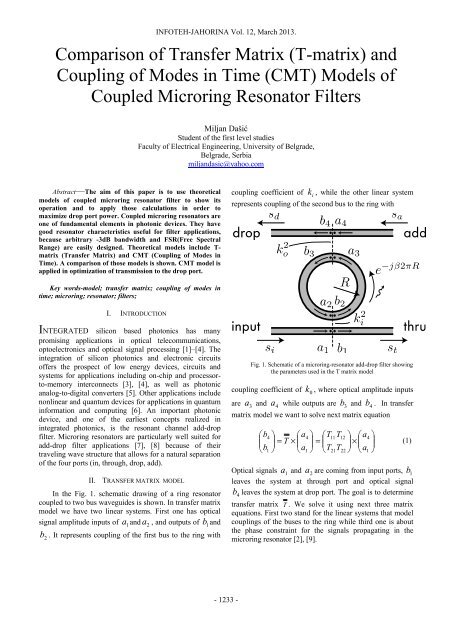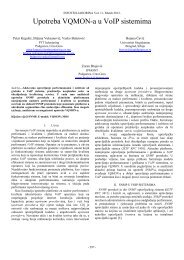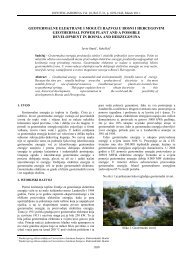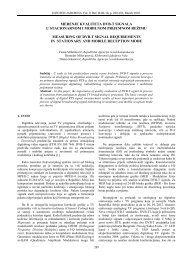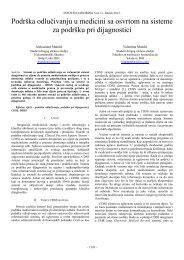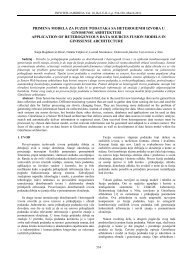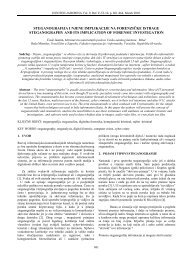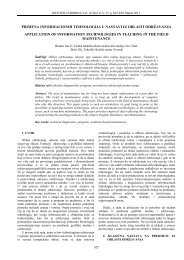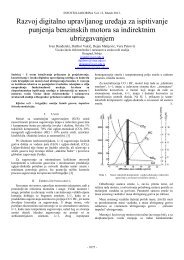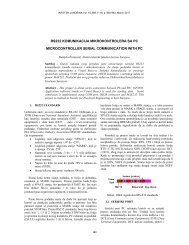Comparison of Transfer Matrix (T-matrix) and Coupling of ... - Infoteh
Comparison of Transfer Matrix (T-matrix) and Coupling of ... - Infoteh
Comparison of Transfer Matrix (T-matrix) and Coupling of ... - Infoteh
You also want an ePaper? Increase the reach of your titles
YUMPU automatically turns print PDFs into web optimized ePapers that Google loves.
INFOTEH-JAHORINA Vol. 12, March 2013.<br />
<strong>Comparison</strong> <strong>of</strong> <strong>Transfer</strong> <strong>Matrix</strong> (T-<strong>matrix</strong>) <strong>and</strong><br />
<strong>Coupling</strong> <strong>of</strong> Modes in Time (CMT) Models <strong>of</strong><br />
Coupled Microring Resonator Filters<br />
Miljan Dašić<br />
Student <strong>of</strong> the first level studies<br />
Faculty <strong>of</strong> Electrical Engineering, University <strong>of</strong> Belgrade,<br />
Belgrade, Serbia<br />
milj<strong>and</strong>asic@yahoo.com<br />
Abstract—The aim <strong>of</strong> this paper is to use theoretical<br />
models <strong>of</strong> coupled microring resonator filter to show its<br />
operation <strong>and</strong> to apply those calculations in order to<br />
maximize drop port power. Coupled microring resonators are<br />
one <strong>of</strong> fundamental elements in photonic devices. They have<br />
good resonator characteristics useful for filter applications,<br />
because arbitrary -3dB b<strong>and</strong>width <strong>and</strong> FSR(Free Spectral<br />
Range) are easily designed. Theoretical models include T-<br />
<strong>matrix</strong> (<strong>Transfer</strong> <strong>Matrix</strong>) <strong>and</strong> CMT (<strong>Coupling</strong> <strong>of</strong> Modes in<br />
Time). A comparison <strong>of</strong> those models is shown. CMT model is<br />
applied in optimization <strong>of</strong> transmission to the drop port.<br />
coupling coefficient <strong>of</strong> k i<br />
, while the other linear system<br />
represents coupling <strong>of</strong> the second bus to the ring with<br />
Key words-model; transfer <strong>matrix</strong>; coupling <strong>of</strong> modes in<br />
time; microring; resonator; filters;<br />
I. INTRODUCTION<br />
INTEGRATED silicon based photonics has many<br />
promising applications in optical telecommunications,<br />
optoelectronics <strong>and</strong> optical signal processing [1]–[4]. The<br />
integration <strong>of</strong> silicon photonics <strong>and</strong> electronic circuits<br />
<strong>of</strong>fers the prospect <strong>of</strong> low energy devices, circuits <strong>and</strong><br />
systems for applications including on-chip <strong>and</strong> processorto-memory<br />
interconnects [3], [4], as well as photonic<br />
analog-to-digital converters [5]. Other applications include<br />
nonlinear <strong>and</strong> quantum devices for applications in quantum<br />
information <strong>and</strong> computing [6]. An important photonic<br />
device, <strong>and</strong> one <strong>of</strong> the earliest concepts realized in<br />
integrated photonics, is the resonant channel add-drop<br />
filter. Microring resonators are particularly well suited for<br />
add-drop filter applications [7], [8] because <strong>of</strong> their<br />
traveling wave structure that allows for a natural separation<br />
<strong>of</strong> the four ports (in, through, drop, add).<br />
II. TRANSFER MATRIX MODEL<br />
In the Fig. 1. schematic drawing <strong>of</strong> a ring resonator<br />
coupled to two bus waveguides is shown. In transfer <strong>matrix</strong><br />
model we have two linear systems. First one has optical<br />
signal amplitude inputs <strong>of</strong> a1<br />
<strong>and</strong> a 2<br />
, <strong>and</strong> outputs <strong>of</strong> b1<br />
<strong>and</strong><br />
b<br />
2<br />
. It represents coupling <strong>of</strong> the first bus to the ring with<br />
Fig. 1. Schematic <strong>of</strong> a microring-resonator add-drop filter showing<br />
the parameters used in the T <strong>matrix</strong> model<br />
coupling coefficient <strong>of</strong> k<br />
0<br />
, where optical amplitude inputs<br />
are a<br />
3<br />
<strong>and</strong> a<br />
4<br />
while outputs are b<br />
3<br />
<strong>and</strong> b<br />
4<br />
. In transfer<br />
<strong>matrix</strong> model we want to solve next <strong>matrix</strong> equation<br />
⎛b<br />
⎜<br />
⎝b<br />
4<br />
1<br />
⎞ ⎛a<br />
⎟ = T ×<br />
⎜<br />
⎠ ⎝a<br />
4<br />
1<br />
⎞ ⎛T<br />
⎟ =<br />
⎜<br />
⎠ ⎝T<br />
11<br />
21<br />
T<br />
T<br />
12<br />
22<br />
⎞ ⎛<br />
× a<br />
⎟<br />
⎜<br />
⎠ ⎝a<br />
Optical signals a<br />
1<br />
<strong>and</strong> a2<br />
are coming from input ports, b<br />
1<br />
leaves the system at through port <strong>and</strong> optical signal<br />
b4<br />
leaves the system at drop port. The goal is to determine<br />
transfer <strong>matrix</strong> T . We solve it using next three <strong>matrix</strong><br />
equations. First two st<strong>and</strong> for the linear systems that model<br />
couplings <strong>of</strong> the buses to the ring while third one is about<br />
the phase constraint for the signals propagating in the<br />
microring resonator [2], [9].<br />
4<br />
1<br />
⎞<br />
⎟<br />
⎠<br />
(1)<br />
- 1233 -
⎛b<br />
⎛ − − ⎞<br />
1 ⎞ ⎛a<br />
⎞ 1 k<br />
1 ⎜<br />
i<br />
j ki<br />
⎟ ⎛a1<br />
⎞<br />
⎜<br />
⎟ = t ×<br />
⎜<br />
⎟ =<br />
×<br />
⎜<br />
⎟<br />
⎝b<br />
⎠ ⎝ ⎠<br />
⎜ − ⎟<br />
2<br />
a2<br />
⎝−<br />
j k 1 k ⎠ ⎝a<br />
i i 2 ⎠<br />
(2)<br />
⎛b<br />
⎛ − − ⎞<br />
3 ⎞ ⎛a<br />
⎞ 1 k<br />
3 ⎜<br />
o<br />
j ko<br />
⎟ ⎛a3<br />
⎞<br />
⎜<br />
⎟ = τ ×<br />
⎜<br />
⎟ =<br />
×<br />
⎜<br />
⎟<br />
⎝b<br />
⎠ ⎝ ⎠<br />
⎜ − ⎟<br />
4<br />
a4<br />
⎝−<br />
j k 1 k ⎠ ⎝a<br />
o o 4 ⎠<br />
(3)<br />
⎛a<br />
⎜<br />
⎝a<br />
2<br />
− jβπR<br />
⎞ ⎛e<br />
⎞ ⎛b<br />
⎟ = ⎜ ⎟<br />
×<br />
⎜<br />
− jβπR<br />
⎠ ⎝0 e ⎠ ⎝b<br />
3<br />
0<br />
In Eq. 4 j is imaginary one, βπR<br />
is the product <strong>of</strong><br />
propagation constant <strong>and</strong> half <strong>of</strong> the circumference <strong>of</strong> the<br />
ring <strong>and</strong> term R is inner radius <strong>of</strong> the ring. The expression<br />
for beta is<br />
2π<br />
β n ×<br />
(5)<br />
= g<br />
where n is group refractive index. We use notation:<br />
g<br />
λ<br />
⎛t11<br />
t12<br />
⎞<br />
t =<br />
⎜<br />
⎟<br />
⎝t21t22<br />
⎠<br />
⎛τ11τ12<br />
⎞<br />
τ =<br />
⎜<br />
⎟<br />
⎝τ<br />
21τ<br />
22 ⎠<br />
When <strong>matrix</strong> equations are written in developed form, we<br />
obtain<br />
b = t<br />
b<br />
b<br />
b<br />
1<br />
2<br />
3<br />
4<br />
11<br />
= t<br />
21<br />
11<br />
21<br />
1<br />
1<br />
= τ a<br />
3<br />
= τ a<br />
a + t<br />
3<br />
12<br />
a + t<br />
22<br />
a<br />
12<br />
22<br />
2<br />
a<br />
2<br />
+ τ a<br />
4<br />
+ τ a<br />
Together with the phase constraints<br />
a<br />
a<br />
3<br />
2<br />
= b × e<br />
2<br />
= b × e<br />
3<br />
− jβπR<br />
− jβπR<br />
The algorithm is to solve Eq. 7.4 for a3<br />
<strong>and</strong> to obtain b2<br />
in<br />
terms <strong>of</strong> a4<br />
<strong>and</strong> b4<br />
using Eq. 8.1. Then plug in a 3<br />
to Eq.<br />
7.3 which leads to an expression <strong>of</strong> b 3<br />
in terms <strong>of</strong><br />
( a<br />
4<br />
, b<br />
4<br />
). We were using Eq. 8.1, Eq. 7.3 <strong>and</strong> Eq. 7.4. In<br />
similar way using Eq. 8.2, Eq. 7.1 <strong>and</strong> Eq. 7.2 we solve<br />
a2<br />
<strong>and</strong> b2<br />
in terms <strong>of</strong> ( a<br />
1<br />
, b<br />
1<br />
). Then we have to combine<br />
expressions obtained by this separate solvings using<br />
4<br />
2<br />
3<br />
⎞<br />
⎟<br />
⎠<br />
(4)<br />
(6)<br />
(7)<br />
(8)<br />
constraint equations (Eq. 8.1 <strong>and</strong> Eq. 8.2) which leads to<br />
this solution<br />
b<br />
4<br />
1<br />
= T<br />
11<br />
b = T a<br />
21<br />
a<br />
4<br />
4<br />
+ T<br />
+ T<br />
like in Eq. 1, where expressions for transfer <strong>matrix</strong><br />
elements are<br />
T<br />
11<br />
T<br />
22<br />
τ<br />
=<br />
22<br />
T<br />
T<br />
t<br />
=<br />
12<br />
21<br />
11<br />
− j 2βπR<br />
+ e t<br />
−<br />
(1 − e<br />
22<br />
j 2<br />
12<br />
22<br />
a<br />
a<br />
1<br />
1<br />
( τ12τ<br />
21<br />
−τ11τ<br />
22<br />
)<br />
βπR<br />
τ t )<br />
11 22<br />
− jβπR<br />
e τ<br />
21t21<br />
=<br />
− j 2βπR<br />
( 1−<br />
e τ11t22)<br />
− jβπR<br />
e t12τ<br />
12<br />
=<br />
− j2βπR<br />
( 1−<br />
e τ11t22)<br />
− j 2βπR<br />
+ e τ11(<br />
t12t21<br />
− t<br />
− j 2βπR<br />
(1 − e τ t )<br />
11 22<br />
t<br />
11 22<br />
)<br />
(9)<br />
(10)<br />
Here T12<br />
represents normalized drop port power <strong>and</strong> T 22<br />
represents normalized through port power. Now we apply<br />
those expressions from Eq. 10 to calculate spectral<br />
response <strong>of</strong> a filter made <strong>of</strong> two bus waveguides that are<br />
coupled to the microring-resonator. We have chosen free<br />
spectral range <strong>of</strong> 2 THz <strong>and</strong> -3dB b<strong>and</strong>width <strong>of</strong> 40 GHz. It<br />
is known that free spectral range <strong>of</strong> a microring-resonator<br />
is determined by ring’s radius [2].<br />
c<br />
c<br />
FSR = ⇒ R =<br />
(11)<br />
2πRn<br />
2πn<br />
FSR<br />
g<br />
Taking the Eq. 12 from reference [1] <strong>and</strong> using<br />
c c<br />
λ = ⇒ dλ<br />
=<br />
2<br />
f f<br />
df (12)<br />
gives us the relation for -3dB b<strong>and</strong>width<br />
2<br />
π ⋅ Δf dB<br />
= k 2FSR<br />
(13)<br />
−3 ⋅<br />
Therefore we define normalized coupling<br />
× Δf −3dB<br />
ξ = π<br />
(14)<br />
2FSR<br />
Delay in group time is calculated using this formula<br />
1 dΦ<br />
t g<br />
= −<br />
2π df<br />
where Φ is the phase <strong>and</strong> f is the frequency.<br />
g<br />
(15)<br />
- 1234 -
Symmetric coupling<br />
k<br />
i<br />
= k o<br />
= ξ<br />
Assymetric coupling<br />
k<br />
i<br />
=<br />
o<br />
2 ξ,<br />
k = 3ξ<br />
Amplitude <strong>of</strong> T-<strong>matrix</strong> complex elements<br />
1<br />
0.9<br />
0.8<br />
0.7<br />
0.6<br />
0.5<br />
0.4<br />
0.3<br />
0.2<br />
<strong>Transfer</strong> <strong>matrix</strong> method<br />
T11<br />
T21<br />
T12<br />
T22<br />
Amplitude <strong>of</strong> T-<strong>matrix</strong> complex elements<br />
1<br />
0.9<br />
0.8<br />
0.7<br />
0.6<br />
0.5<br />
0.4<br />
0.3<br />
0.2<br />
<strong>Transfer</strong> <strong>matrix</strong> method<br />
T11<br />
T21<br />
T12<br />
T22<br />
0.1<br />
0.1<br />
Phase <strong>of</strong> T-<strong>matrix</strong> complex elements (rad)<br />
0<br />
193 194 195 196 197 198 199<br />
f (THz)<br />
20<br />
15<br />
10<br />
5<br />
0<br />
(a)<br />
Phases <strong>of</strong> transfer <strong>matrix</strong> complex elements<br />
T11<br />
T21<br />
T12<br />
T22<br />
Phase <strong>of</strong> T-<strong>matrix</strong> complex elements (rad)<br />
0<br />
193 194 195 196 197 198 199<br />
f (THz)<br />
20<br />
15<br />
10<br />
5<br />
0<br />
(a)<br />
Phases <strong>of</strong> transfer <strong>matrix</strong> complex elements<br />
T11<br />
T21<br />
T12<br />
T22<br />
Group time delay (ps)<br />
-5<br />
193 194 195 196 197 198 199<br />
f (THz)<br />
4<br />
3<br />
2<br />
1<br />
0<br />
-1<br />
(b)<br />
Delay in group time<br />
T11<br />
T12<br />
T21<br />
T22<br />
Group time delay (ps)<br />
-5<br />
193 194 195 196 197 198 199<br />
f (THz)<br />
4<br />
3<br />
2<br />
1<br />
0<br />
-1<br />
(b)<br />
Delay in group time<br />
T11<br />
T12<br />
T21<br />
T22<br />
-2<br />
-2<br />
-3<br />
193 194 195 196 197 198 199<br />
f (THz)<br />
(c)<br />
Fig. 2. Frequency spectra <strong>of</strong> T-<strong>matrix</strong> elements’<br />
amplitude, phase <strong>and</strong> group time delay - (a), (b), (c)<br />
-3<br />
193 194 195 196 197 198 199<br />
f (THz)<br />
(c)<br />
Fig. 3. Frequency spectra <strong>of</strong> T-<strong>matrix</strong> elements’<br />
amplitude, phase <strong>and</strong> group time delay - (a), (b), (c)<br />
- 1235 -
In Fig. 2 <strong>and</strong> Fig. 3 frequency spectra <strong>of</strong> T-<strong>matrix</strong><br />
elements’ amplitude, phase <strong>and</strong> group time delay are given,<br />
in symmetric <strong>and</strong> chosen asymmetric case, respectively.<br />
We can notice that symmetric coupling affords 100%<br />
transmission to the drop port. In the phase <strong>and</strong> group time<br />
delay plots we can notice differentiation <strong>of</strong> the bus lines,<br />
caused by the asymmetric coupling.<br />
III. COUPLING OF MODES IN TIME (CMT) MODEL<br />
Coupled-mode theory in time (CMT) provides a<br />
simple model that affords all necessary physics <strong>of</strong> the<br />
resonant add-drop filter problem, including resonance, loss<br />
<strong>and</strong> coupling to input <strong>and</strong> output ports [1,2,6]. The system<br />
<strong>of</strong> equations that describes a single-resonator filter excited<br />
by a monochromatic input wave at angular frequency ω is<br />
d<br />
dt<br />
a t)<br />
= jωa(<br />
t)<br />
= ( jω<br />
− r)<br />
a(<br />
t)<br />
− j<br />
(<br />
0<br />
s ( t)<br />
= s ( t)<br />
− j<br />
t<br />
s ( t)<br />
= − j<br />
d<br />
i<br />
2r<br />
d<br />
2r<br />
a(<br />
t)<br />
e<br />
a(<br />
t)<br />
2r<br />
s ( t)<br />
e<br />
i<br />
(16)<br />
where a(t) is energy amplitude <strong>of</strong> the ring resonant mode,<br />
s i , s t , s d , are the power-normalized amplitudes <strong>of</strong> input,<br />
through <strong>and</strong> drop port waves [2]. With input wave s i<br />
incident, some excitation is picked up by the resonator, <strong>and</strong><br />
the remaining field interferes with that leaving the<br />
resonator in the through port <strong>and</strong> is carried away by<br />
through-port wave s t . The energy stored in the resonator is<br />
|a(t)| 2 <strong>and</strong> according to Eqs. (16) the energy amplitude a(t)<br />
decays at a total rate r, comprising decay rates describing<br />
external coupling to the input port, r e , to the drop port, r d ,<br />
<strong>and</strong> to loss mechanisms, r o :<br />
r = r e<br />
+ r d<br />
+ r o<br />
(17)<br />
The coupling rates r e <strong>and</strong> r d are determined in the<br />
evanescent-coupling geometry in Fig. 8 by the size <strong>of</strong> the<br />
ring-waveguide coupling gaps [1,9]. The decay rates are<br />
related to decay time constants as r i = 1/τ I , for i = {e,d,o}.<br />
Since τ is a field time constant, the associated photon<br />
lifetime <strong>of</strong> the resonant cavity (which measures decay <strong>of</strong><br />
intensity) is τ/2.<br />
The through-port <strong>and</strong> drop-port responses <strong>of</strong> the device<br />
can be found from Eqs. (16) as<br />
2<br />
s t<br />
= (ω −ω 0 )2 + (r 0<br />
+ r d<br />
− r e<br />
) 2<br />
(18)<br />
s i<br />
(ω −ω 0<br />
) 2 + (r 0<br />
+ r d<br />
+ r e<br />
) 2<br />
2<br />
s d<br />
=<br />
s i<br />
4r e<br />
r d<br />
(19)<br />
( ω −ω 0 ) 2 + r 2<br />
The drop-port response is Lorentzian, with a full 3dB<br />
b<strong>and</strong>width Δω 3dB = 2r.<br />
Unlike a full scattering model (T <strong>matrix</strong> model) using<br />
transfer matrices, the CMT model addresses only one<br />
resonant mode <strong>of</strong> the ring <strong>and</strong> does not include geometry<br />
information that can define a free spectral range (FSR).<br />
Resonant frequencies are determined by the resonant<br />
condition<br />
f<br />
m<br />
c<br />
= m<br />
(20)<br />
2πRn<br />
where c is the speed <strong>of</strong> light in vacuum, R is the ring<br />
resonator radius, <strong>and</strong> n eff is the (frequency dependent)<br />
effective index <strong>of</strong> the guided mode. The FSR is given by<br />
c<br />
Δf FSR<br />
=<br />
(21)<br />
2π Rn g<br />
where n<br />
g<br />
is group effective index <strong>of</strong> the guided mode.<br />
Fig. 4. Schematic <strong>of</strong> a single microring-resonator add-drop filter showing<br />
the parameters used in the CMT model.<br />
IV. CORRESPONDENCE OF CMT AND T-MATRIX<br />
MODELS<br />
We have derived T-<strong>matrix</strong> <strong>and</strong> CMT models <strong>of</strong><br />
coupled microring resonator filters. Now we will compare<br />
those models. In Fig. 5 we show wavelength spectra <strong>of</strong><br />
amplitude in linear <strong>and</strong> db scale. The task is to connect<br />
coupling coefficients k<br />
i<br />
, ko<br />
from T-<strong>matrix</strong> model with<br />
decay rates r , r . There is a direct relation [1]<br />
e<br />
d<br />
2<br />
rm = 2 kn<br />
× FSR<br />
(22)<br />
for m = {e,d} <strong>and</strong> n={i,o}. Using normalized couplings<br />
from Eq. (14) we obtain expression for decay rates as<br />
r ⋅ Δf<br />
−3dB<br />
eff<br />
= π (23)<br />
We are showing the results <strong>of</strong> comparison for symmetric<br />
coupling, with zero losses. One disadvantage <strong>of</strong> T-<strong>matrix</strong><br />
model is that it does not model losses while CMT model<br />
includes losses. On the other side, T-<strong>matrix</strong> shows free<br />
spectral range <strong>and</strong> multiple resonances while CMT model<br />
has only one resonant wavelength. In Fig. 5(b) we can<br />
- 1236 -
notice that deviation <strong>of</strong> CMT Lorentzian from T-<strong>matrix</strong><br />
trace is bigger on dB scale than on linear scale in Fig.5 (a).<br />
1<br />
0.9<br />
<strong>Comparison</strong> <strong>of</strong> CMT <strong>and</strong> T-<strong>matrix</strong> models<br />
1<br />
0.9<br />
0.8<br />
0.7<br />
CMT <strong>Transfer</strong> functions <strong>of</strong> drop port, through port <strong>and</strong> loss<br />
Drop port<br />
Through port<br />
Losses<br />
Transmission<br />
Transmission (dB)<br />
0.8<br />
0.7<br />
0.6<br />
0.5<br />
0.4<br />
0.3<br />
0.2<br />
0.1<br />
Drop Port (CMT)<br />
Through Port (CMT)<br />
T11<br />
T21<br />
T12<br />
T22<br />
0<br />
1.51 1.515 1.52 1.525 1.53 1.535 1.54 1.545 1.55<br />
Wavelength (um)<br />
0<br />
-5<br />
-10<br />
-15<br />
-20<br />
-25<br />
-30<br />
-35<br />
-40<br />
-45<br />
-50<br />
(a)<br />
<strong>Comparison</strong> <strong>of</strong> CMT <strong>and</strong> T-<strong>matrix</strong> models<br />
Drop Port (CMT)<br />
Through Port (CMT)<br />
T11<br />
T21<br />
T12<br />
T22<br />
-55<br />
1.51 1.515 1.52 1.525 1.53 1.535 1.54 1.545 1.55<br />
Wavelength (um)<br />
(b)<br />
Fig. 5. <strong>Comparison</strong> <strong>of</strong> CMT <strong>and</strong> T-<strong>matrix</strong> models (wavelength spectra <strong>of</strong><br />
amplitude) linear (a) <strong>and</strong> dB scale (b)<br />
V. OPTIMAL AND CRITICAL COUPLING<br />
We apply CMT model in order to optimize drop port<br />
transmission. Fixing the b<strong>and</strong>width means fixing the total<br />
rate r, according to Eq. (17) <strong>and</strong>, together with a fixed loss<br />
rate, there is only one degree <strong>of</strong> freedom left. Taking the<br />
first derivative <strong>of</strong> Eq. (19) in respect to r e<br />
<strong>and</strong> setting this<br />
to zero gives<br />
r − r<br />
r r<br />
0<br />
e<br />
=<br />
d<br />
=<br />
(24)<br />
2<br />
From setting Eq. (18) to zero on-resonance, we derive the<br />
couplings <strong>of</strong> critically coupled filter<br />
r<br />
e<br />
rd<br />
+ r 0<br />
= (25)<br />
Transmission<br />
Transmission<br />
0.6<br />
0.5<br />
0.4<br />
0.3<br />
0.2<br />
0.1<br />
0<br />
1.48 1.5 1.52 1.54 1.56 1.58 1.6 1.62<br />
Wavelength (um)<br />
1<br />
0.9<br />
0.8<br />
0.7<br />
0.6<br />
0.5<br />
0.4<br />
0.3<br />
0.2<br />
0.1<br />
(a)<br />
CMT <strong>Transfer</strong> functions <strong>of</strong> drop port, through port <strong>and</strong> loss<br />
Drop port<br />
Through port<br />
Losses<br />
0<br />
1.48 1.5 1.52 1.54 1.56 1.58 1.6 1.62<br />
Wavelength (um)<br />
(b)<br />
Fig. 6. CMT transmission (drop port, through port <strong>and</strong> losses) in optimally<br />
<strong>and</strong> critically coupled filters – (a), (b)<br />
In Fig. 6 transmission spectra <strong>of</strong> through <strong>and</strong> drop port is<br />
given for optimally <strong>and</strong> critically coupled filters. A<br />
comparison <strong>of</strong> the transmission efficiency <strong>of</strong> the optimal<br />
symmetric [Eq. (24)] <strong>and</strong> critical coupling [Eq. (25)]<br />
designs is given in Fig. 7, showing that the symmetric<br />
design is indeed optimal for maximizing dropped onresonant<br />
power. We define a normalized b<strong>and</strong>width, α ,<br />
by normalizing the 3dB b<strong>and</strong>width Δf 3dB by the intrinsic<br />
linewidth Δf o due to the loss rate r o , i.e. loss Q, Q o .<br />
Substitution <strong>of</strong> the solutions <strong>of</strong> Eq. (24) <strong>and</strong> Eq. (25) into<br />
Eq. (19) provides the normalized efficiency <strong>of</strong> the<br />
symmetric <strong>and</strong> critically coupled designs given in Eq. (26).<br />
2<br />
s d<br />
s i optimal<br />
2<br />
s d<br />
s i critical<br />
2<br />
⎛<br />
= 1− 1 ⎞<br />
⎜ ⎟<br />
⎝ α ⎠ . (26)<br />
=1− 2 α<br />
- 1237 -
ACKNOWLEDGEMENT<br />
Author is very thankfull for all the support <strong>of</strong> pr<strong>of</strong>essor<br />
Miloš A. Popović, who was the supervisor <strong>of</strong> the research<br />
presented in this paper. First <strong>of</strong> all, he gave me a great<br />
opportunity to work as a research intern in his<br />
Nanophotonic Systems Laboratory at Electrical, Computer<br />
<strong>and</strong> Energy Engineering Department, University <strong>of</strong><br />
Colorado Boulder, United States <strong>of</strong> America. His ideas <strong>and</strong><br />
comments guided me through this research. Many thanks to<br />
all the people from our group - Savvy, Chris, Kareem,<br />
Mark, Cale, Jeff <strong>and</strong> Yangyang whose support <strong>and</strong> help<br />
made my work more efficient.<br />
REFERENCES<br />
Fig. 7. Minimizing the impact <strong>of</strong> loss on a single filter stage: comparison<br />
<strong>of</strong> symmetric (optimal) <strong>and</strong> critically coupled single-ring filter designs for<br />
different normalized b<strong>and</strong>widths, (ratio <strong>of</strong> total b<strong>and</strong>width to losslimited,<br />
intrinsic b<strong>and</strong>width). Ref. [12]<br />
TABLE I<br />
MINIMUM NORMALIZED BANDWIDTH FOR 3DB DROP-PORT POWER<br />
Symmetric coupling<br />
Critical coupling<br />
2<br />
≈ 3,412 4<br />
2 −1<br />
VI. CONCLUSION<br />
<strong>Transfer</strong> <strong>matrix</strong> model <strong>of</strong> a photonic microringresonator<br />
channel add-drop filter has been solved <strong>and</strong><br />
applied to design a filter with chosen free spectral range<br />
(FSR) <strong>and</strong> -3dB b<strong>and</strong>width ( Δ f 3 dB<br />
). The results <strong>of</strong> those<br />
calculations are given for symmetric <strong>and</strong> asymmetric<br />
coupling. CMT model was solved <strong>and</strong> applied in order to<br />
maximize drop port power <strong>of</strong> a single ring filter. We have<br />
determined how to choose optimal couplings <strong>and</strong> then<br />
compared this to the case <strong>of</strong> critical coupling. This<br />
comparison is useful in the design process to determine the<br />
narrowest b<strong>and</strong>width that supports a desired transmission<br />
to the drop port, or the maximum transmission achievable<br />
at a certain b<strong>and</strong>width, given known linear losses. Fig. 7<br />
<strong>and</strong> Eqs. (26) show that the optimum symmetric design has<br />
a minimum b<strong>and</strong>width limit <strong>of</strong> Δf o , while the critically<br />
coupled design has a minimum b<strong>and</strong>width <strong>of</strong> 2Δf o . In the<br />
limit <strong>of</strong> a large b<strong>and</strong>width α, the loss plays a negligible role<br />
<strong>and</strong> the two solutions can be verified by a first-order Taylor<br />
series expansion <strong>of</strong> Eqs. (26) to be equal.<br />
[1] B. E. Little, S. T. Chu, H. A. Haus, J. Foresi <strong>and</strong> J.-P. Laine,<br />
“Microring Resonator Channel Dropping Filters”, Journal <strong>of</strong><br />
Ligthwave Technology, June 1997, vol. 15, No. 6<br />
[2] H. A. Haus, “Waves <strong>and</strong> Fields in Optoelectronics”, Englewood<br />
Cliffs, NJ: Prentice-Hall, 1984.<br />
[3] J.S. Orcutt, B. Moss, C. Sun, J. Leu, M. Georgas, J. Shainline, E.<br />
Zgraggen, H. Li, J. Sun, M. Weaver, S. Urosevic, M.A. Popovic,<br />
R.J. Ram <strong>and</strong> V.M. Stojanovic, “An Open Foundry Platform for<br />
High-Performance Electronic-Photonic Integration”, Optics Express<br />
20, 12222-12232 (2012).<br />
[4] H. A. Haus <strong>and</strong> Y. Lai, “Narrow-b<strong>and</strong> optical channel-dropping<br />
filter”, Journal <strong>of</strong> Lightwave Technol. Jan. 1992.,vol. 10<br />
[5] A. Khilo et al., “Photonic ADCs: Overcoming the Electronic Jitter<br />
Bottleneck,” Optics Express 20, pp. 4454-4469 (2012).<br />
[6] S. Clemmen, K. Phan Huy, et al., “Continuous wave photon pair<br />
generation in silicon-on-insulator waveguides <strong>and</strong> ring resonators”,<br />
Optics Express 17, 16558-16570 (2009).<br />
[7] B. E. Little, J. S. Foresi, G. Steinmeyer, E. R. Thoen, S. T. Chu, H.<br />
A. Haus, E. P. Ippen, L. C. Kimerling, <strong>and</strong> W. Greene, “Ultracompact<br />
Si – SiO2 microring resonator optical channel dropping<br />
filters”, IEEE Photon. Technol. Lett., vol. 10, pp. 549–551, Apr.<br />
1998.<br />
[8] C. Manolatou, M. J. Khan, Shanhui Fan, Pierre R. Villeneuve,H. A.<br />
Haus, Life Fellow, IEEE, <strong>and</strong> J. D. Joannopoulos,“<strong>Coupling</strong> <strong>of</strong><br />
Modes Analysis <strong>of</strong> Resonant Channel Add–Drop Filters”, IEEE<br />
Journal <strong>of</strong> Quantum Electronics, vol.. 35, no. 9, September 1999.<br />
[9] A. Yariv <strong>and</strong> P. Yeh, “Photonics – Optical Electronics in Modern<br />
Communications”, New York Oxford, Oxford University Press,<br />
2007.<br />
[10] Andreas Vörckel, Mathias Mönster, Wolfgang Henschel, Peter<br />
Haring Bolivar, <strong>and</strong> Heinrich Kurz, ”Asymmetrically Coupled<br />
Silicon-On-Insulator Microring Resonators for Compact Add–Drop<br />
Multiplexers“, IEEE Photonics Technology Letters, vol. 15, no. 7,<br />
July 2003<br />
[11] M.A. Popović, “Sharply-defined optical filters <strong>and</strong> dispersionless<br />
delay lines based on loop-coupled resonators <strong>and</strong> ‘negative’<br />
coupling,” in Conference on Lasers <strong>and</strong> Electro-Optics(CLEO),2007<br />
[12] M. Dašić <strong>and</strong> M.A. Popović, “Minimum Drop Loss Design <strong>of</strong><br />
Microphotonic Microring Resonator Channel Add-Drop Filters”,<br />
Telecommunications Forum (TELFOR) 2012, Belgrade, Serbia<br />
- 1238 -


